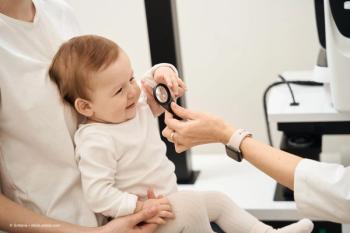
Q&A: Vivienne S. Hau, MD, PhD, discusses racial and ethnic disparities in retinoblastoma treatment options
Vivienne S. Hau, MD, PhD, presented research on retinoblastoma diagnosis disparities using data from 69 healthcare systems over 20 years, covering 11,000 patients at the 2025 ASRS meeting, which was held in Long Beach, California. Hau is a vitreoretinal surgeon with Southern California Permanente Group. I'm also on faculty at the Bernard J Tyson School of Medicine, Kaiser Permanente Med School, and also at the California University School of Medicine.
The study found Native Hawaiians and Native Americans were diagnosed later than whites and Blacks, leading to higher rates of enucleation (advanced treatment). These disparities likely stem from social determinants rather than biological differences, including limited healthcare access and socioeconomic factors. Medical student, Marina Gad El Sayed, contributed to the research, emphasizing the broader implications for addressing health disparities across medical specialties.
Note: The following conversation has been lightly edited for clarity.
Modern Retina: Can you share how the researchers gathered the data used in this study and what this data revealed?
Vivienne S. Hau, MD, PhD: What was interesting with this study is we targeted specifically the race and ethnicities of many of these patients who were diagnosed with retinoblastoma and comparing them to those type of treatments that they received in correlation with their age of diagnosis, because we wanted to see if there were differences in their presentation, it was early on or later on, though similar to based upon their race and ethnicity or also the type of treatment that they had received. Now, there have been previous studies that have shown some of this data, but they're old, and they've been mainly focused on a single institution. What's unique about our data is we did a multi-institutional approach. By using a TriNetX database. We looked specifically at our domestic database, which encompasses 69 healthcare systems, and through that, over the course of 20 years, we were able to find over 11,000 retinoblastoma patients, where we were able to demonstrate that certain races and ethnicities had delayed diagnosis of retinoblastoma.
Native Hawaiians and Native Americans tended to skew later, where Whites, as one might guess, skewed a little bit earlier on, and also, interestingly, Blacks did too. Now, along with that, we also saw that correlated with the rates of enucleation and chemotherapy. Typically, we view nucleation as a type of therapy that's for advanced disease, and one we try to avoid, but when it's advanced disease, sometimes that's our only choice. So we saw in populations that were non-white, not Black either that they tend to skew more nucleation, and since they're also being diagnosed at a later age, that perhaps they have more advanced age.
MR: How might we interpret these results?
Hau: I think one of the most important things is to understand why this is happening. I don't think it's because of any sort of biological differences in many of the patients. I think the reality is more about the social determinants of health. Are these patients being screened? Are they getting the care at an early age? Some of which, maybe some of these patients, because those in certain types of race and ethnicities, they tend to be at lower social economic status, where they may not have access to early care for these babies, or maybe they live too far away from specialized care, like pediatric oncologists. So we need to look at the system as a whole to see how these patients are getting the care, and they're getting it on a timely basis.
MR: Who made up this research team?
Hau: Part of this study, it was done by the hard work of 3 medical students that I mentor at UC Riverside. That was Dhiresh Bandaru, Anh-Thy Nguyen, and also Marina Gad El Sayed. And I happen to have Marina here with me, and I would love for her to answer some questions, since she did the hard work.
MR: Can you share a bit about yourself?
Marina Gad El Sayed: My name is Marina Gad El Sayed, and I am a third year medical student at University of California Riverside School of Medicine.
MR: How did you become a part of this project?
Gad El Sayed: So actually, I was really fortunate to have one of my mentors, Anh-Thy Nguyen, who graciously invited me to work on this project with her. It was her original idea to do this project. She is very passionate about pediatric health disparities, and that also was where my passion came from, especially when it came to ophthalmic care. I recently just finished my family medicine rotation at UC Riverside, and I saw firsthand how much an incidental finding of the eye that could be noticed at a well child visit might not go addressed until a year or two later, because of the process of referral and shortage in care and just the amount of care gaps that are still yet to be filled. So that is also where I bring my passion into this project, because I was interested in finding out on a large scale, the different health disparities that ethnic and racial groups are experiencing in children diagnosed with retinoblastoma. I think that it's not just with retinoblastoma, which is a rare condition, that we see such health disparities. I think a big health disparity that we see right now is in diabetes, of course, and diabetic retinopathy, especially for folks who are having trouble keeping their A1c levels, and diabetes in general, under control. And in general, that's not something that only ophthalmologists have to worry about. It's something that all medical specialties and of course, primary care physicians in the front lines have to be concerned about and proactive about catching it.
MR: How will these takeaways impact your approach to caring for future patients?
Gad El Sayed: So now that I'm aware of the different racial and ethnic disparities that exist in the United States healthcare system as a whole. I'm going to use that in every patient encounter, just to be that much more mindful of who I'm talking to as a patient, what their risk factors are, and how I can help be preventative instead of fixing the problem after it happens already.
Newsletter
Keep your retina practice on the forefront—subscribe for expert analysis and emerging trends in retinal disease management.















































